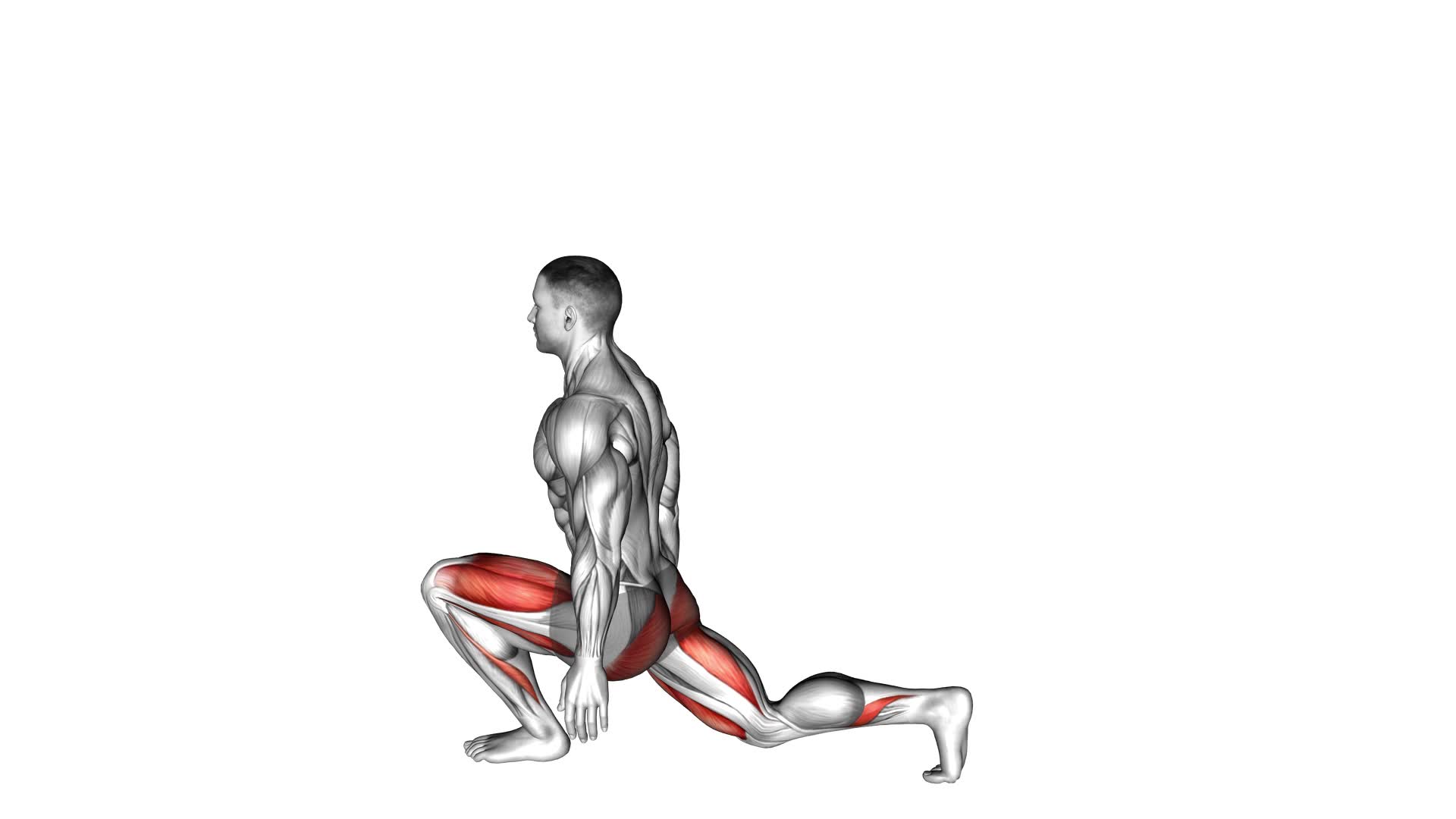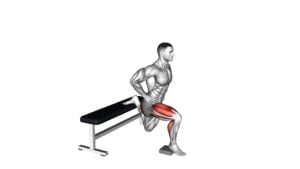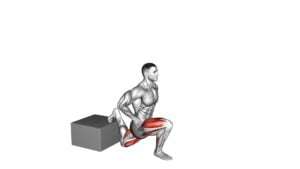Bodyweight Low Split Squat (male) – Video Exercise Guide & Tips

In this article, you'll discover the benefits of the bodyweight low split squat, a powerful exercise for men. With our video exercise guide and helpful tips, you'll learn the proper form and technique to maximize your workout.
Watch This Exercise Video
Whether you're a beginner or advanced, we've got modifications for all fitness levels. Avoid common mistakes and get the most out of this exercise with our expert advice.
Get ready to level up your lower body strength and stability. Let's dive in!
Key Takeaways
- Activates multiple muscle groups in legs and glutes
- Promotes muscle activation and growth
- Enhances overall body control and coordination
- Maintain proper form to engage the right muscles and reduce the risk of injury
Benefits of Bodyweight Low Split Squat
To maximize your lower body strength and stability, performing the bodyweight low split squat regularly can provide significant benefits. This exercise is highly effective in activating multiple muscle groups, making it an excellent choice for building strength in your legs and glutes. By placing one foot forward and the other foot back, you engage your quadriceps, hamstrings, and glutes in a way that promotes muscle activation and growth.
In addition to muscle activation, the bodyweight low split squat also improves balance and stability. The split stance requires you to stabilize your body and maintain proper alignment throughout the movement. This helps to strengthen the muscles responsible for balance, such as the core and hip stabilizers.
Furthermore, the bodyweight low split squat is a functional exercise that mimics movements you perform in daily activities and sports. It improves your overall body control and coordination, making you more efficient and less prone to injuries.
To maximize the benefits of this exercise, focus on maintaining proper form and control throughout each repetition. Start with your feet hip-width apart, take a step forward, and lower your back knee towards the ground while keeping your front knee aligned with your ankle. Push through your front heel to return to the starting position. Remember to breathe steadily and engage your core for optimal stability.
Incorporate the bodyweight low split squat into your lower body workout routine to achieve stronger muscles, improved balance, and enhanced stability.
Proper Form and Technique
Maintain proper form and technique while performing the bodyweight low split squat to maximize its benefits. Proper form ensures that you engage the right muscles and reduce the risk of injury. When performing this exercise, focus on muscle activation and breathing techniques.
To activate the muscles effectively, start by standing with your feet hip-width apart. Take a big step forward with one foot and lower your body down by bending both knees. Keep your front knee directly above your ankle and your back leg straight. Your back knee should hover just above the ground. As you lower down, engage your glutes, quadriceps, and hamstrings to control the movement.
Breathing is also crucial during the bodyweight low split squat. Inhale as you lower your body, and exhale as you push back up to the starting position. This helps stabilize your core and provides energy for the movement.
By maintaining proper form, activating the target muscles, and using proper breathing techniques, you can maximize the benefits of the bodyweight low split squat.
Now that you understand the importance of form and technique, let's explore modifications for different fitness levels.
Modifications for Different Fitness Levels
Start by assessing your current fitness level and choose the appropriate modifications for the bodyweight low split squat. It's important to tailor the exercise to your abilities to ensure proper form and prevent injury.
If you're a beginner, there are several variations you can try to gradually build strength and stability. One option is to perform the split squat with your back foot elevated on a step or platform. This reduces the range of motion and places less stress on your muscles.
Another variation is to use a resistance band or hold onto a stable object for support. This can help with balance and stability while you work on improving your lower body strength. As you progress, you can increase the difficulty by using dumbbells or a barbell for added resistance.
Remember to always listen to your body and make adjustments as needed. By choosing the appropriate modifications, you can gradually work towards performing the bodyweight low split squat with proper form and technique.
Now let's move on to the next section and learn about common mistakes to avoid.
Common Mistakes to Avoid
To ensure proper form and maximize the benefits of the bodyweight low split squat, it's crucial to be aware of and avoid these common mistakes:
- Incorrect alignment: One of the most common mistakes is having an improper alignment of the front knee during the exercise. Make sure your front knee is directly above your ankle and not extending beyond your toes. This will help prevent unnecessary strain on your knee joints and ensure proper technique.
- Lack of stability: Another mistake to avoid isn't maintaining stability throughout the exercise. Your back foot should be firmly planted on the ground, providing a stable base. Additionally, engage your core muscles to maintain balance and control throughout the movement.
- Inadequate depth: It's important to achieve the proper depth in the low split squat to fully engage the muscles and maximize the benefits. Avoid shallow squats by lowering your back knee towards the ground until it's just above the floor. This will ensure that you're getting the most out of each repetition.
Tips for Maximizing Your Workout
To optimize your workout, focus on maintaining proper form and incorporating intensity techniques. By doing so, you can maximize your results and improve workout efficiency.
One way to maximize your results is by ensuring that you're performing each exercise with proper form. This means maintaining proper alignment, engaging the appropriate muscles, and avoiding any jerky or uncontrolled movements. By doing exercises correctly, you'll target the intended muscle groups more effectively, leading to better results.
Incorporating intensity techniques into your workout can also help maximize your results. These techniques include techniques such as supersets, drop sets, and tempo variations. Supersets involve performing two exercises back to back without resting in between, targeting different muscle groups or the same muscle group from different angles. Drop sets involve performing a set of an exercise to failure and then immediately reducing the weight and continuing for additional reps. Tempo variations involve manipulating the speed at which you perform an exercise, such as slowing down the eccentric (lowering) phase or pausing at the bottom of a movement.
By incorporating these intensity techniques, you can challenge your muscles in new ways and push them to work harder, leading to increased muscle growth and strength gains. Additionally, these techniques can help keep your workouts interesting and prevent plateaus in your progress.
Remember to always listen to your body and adjust the intensity and volume of your workouts as needed to avoid overtraining and injury.
Frequently Asked Questions
How Many Calories Can I Expect to Burn During a Bodyweight Low Split Squat Workout?
During a bodyweight low split squat workout, you can expect to burn a significant amount of calories. This exercise engages multiple muscle groups, including your glutes, quads, and hamstrings, which leads to increased calorie burning.
Additionally, the split squat requires balance and stability, further enhancing your overall fitness.
Can Bodyweight Low Split Squats Help Improve My Balance and Stability?
Bodyweight low split squats can be a great exercise for improving your balance and stability. By engaging multiple muscle groups and challenging your core, they help to strengthen the muscles that support your body's stability.
Additionally, bodyweight exercises in general have numerous benefits, such as improving overall strength, flexibility, and coordination. Incorporating bodyweight low split squats into your workout routine can be an effective way to enhance your stability and reap the benefits of bodyweight exercises.
Is It Necessary to Warm up Before Performing Bodyweight Low Split Squats?
Yes, it's necessary to warm up before performing bodyweight low split squats.
Warming up helps increase blood flow to your muscles, making them more flexible and less prone to injury.
It also prepares your body for the demands of the exercise, allowing you to perform with proper form and technique.
Incorporating proper form in bodyweight low split squats is important for preventing strain and maximizing the benefits, such as improved balance and stability.
Can Bodyweight Low Split Squats Help Me Build Muscle in My Legs and Glutes?
Yes, bodyweight low split squats can help you build muscle in your legs and glutes.
By performing this exercise with proper form, you engage your quadriceps, hamstrings, and glute muscles, which can lead to increased strength and muscle development.
Incorporating bodyweight low split squats into a full body workout routine can provide a challenging lower body workout and help you achieve your muscle-building goals.
Remember to maintain proper form and gradually increase the intensity as you progress.
Are There Any Variations of the Bodyweight Low Split Squat That I Can Try to Target Different Muscle Groups?
There are various variations of the bodyweight low split squat that you can try in order to target different muscle groups. By making slight modifications to your form and positioning, you can engage specific muscles more effectively.
For example, you can do a forward lunge or a lateral lunge to shift the focus onto your quads or adductors respectively. Additionally, elevating your front foot or adding weights can further intensify the exercise and target different areas.
Conclusion
In conclusion, the bodyweight low split squat is an effective exercise for strengthening your lower body and improving balance. By following proper form and technique, you can maximize the benefits of this exercise.
It's important to modify the exercise according to your fitness level and avoid common mistakes to prevent injury. Remember to incorporate these tips into your workout routine to achieve optimal results.

Author
Years ago, the spark of my life’s passion ignited in my mind the moment I stepped into the local gym for the first time. The inaugural bead of perspiration, the initial endeavor, the very first surge of endorphins, and a sense of pride that washed over me post-workout marked the beginning of my deep-seated interest in strength sports, fitness, and sports nutrition. This very curiosity blossomed rapidly into a profound fascination, propelling me to earn a Master’s degree in Physical Education from the Academy of Physical Education in Krakow, followed by a Sports Manager diploma from the Jagiellonian University. My journey of growth led me to gain more specialized qualifications, such as being a certified personal trainer with a focus on sports dietetics, a lifeguard, and an instructor for wellness and corrective gymnastics. Theoretical knowledge paired seamlessly with practical experience, reinforcing my belief that the transformation of individuals under my guidance was also a reflection of my personal growth. This belief holds true even today. Each day, I strive to push the boundaries and explore new realms. These realms gently elevate me to greater heights. The unique combination of passion for my field and the continuous quest for growth fuels my drive to break new ground.







